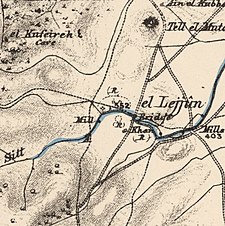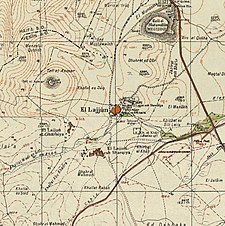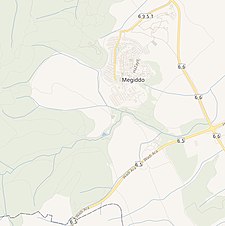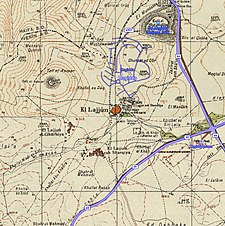
Back اللجون Arabic اللجون ARZ Lajjun Catalan Lajjun Spanish Lajjun Finnish Lajjun French לג'ון HE Lajjun ID Ladżdżun Polish اللجون Urdu
Lajjun
اللجّون Legio, al-Lajjun, el-Lejjun | |
|---|---|
 Lajjun, 1924. Roman or Byzantine columns and modern huts (Rockefeller Museum). | |
A series of historical maps of the area around Lajjun (click the buttons) | |
Location within Mandatory Palestine | |
| Coordinates: 32°34′29″N 35°10′40″E / 32.57472°N 35.17778°E | |
| Palestine grid | 167/220 |
| Geopolitical entity | Mandatory Palestine |
| Subdistrict | Jenin |
| Date of depopulation | May 30, 1948[1] |
| Area | |
• Total | 77,242 dunams (77.242 km2 or 29.823 sq mi) |
| Population (1948) | |
• Total | 1,280 |
| Cause(s) of depopulation | Military assault by Yishuv forces |
| Current Localities | Kibbutz Megiddo[2] |
Lajjun (Arabic: اللجّون, al-Lajjūn) was a large Palestinian Arab village located 16 kilometers (9.9 mi) northwest of Jenin and 1 kilometer (0.62 mi) south of the remains of the biblical city of Megiddo. The Israeli kibbutz of Megiddo, Israel was built 600 metres north-east of the depopulated village on the hill called Dhahrat ed Dar from 1949.
Named after an early Roman legion camp in Syria Palaestina province called "Legio", predating the village at that location, Lajjun's history of habitation spanned some 2,000 years. Under Abbasid rule it was the capital of a subdistrict, during Mamluk rule it served as an important station in the postal route, and during Ottoman rule it was the capital of a district that bore its name. After the collapse of the Ottoman Empire towards the end of World War I, Lajjun and all of Palestine was placed under the administration of the British Mandate. The village was depopulated during the 1948 Arab-Israeli War, when it was captured by Israel. Most of its residents subsequently fled and settled in the nearby town of Umm al-Fahm.




